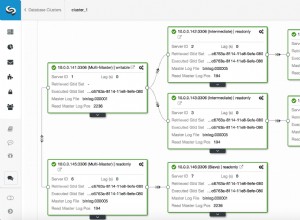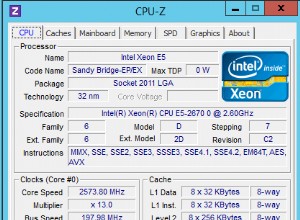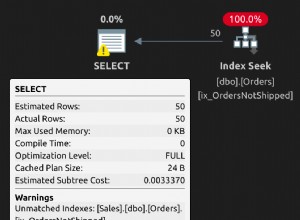J'utiliserais cette procédure stockée pour générer les intervalles dont vous avez besoin dans la table temporaire nommée time_intervals , puis JOIN et agrégez votre table de données avec la temp time_intervals tableau.
La procédure peut générer des intervalles de tous les différents types que vous y voyez spécifiés :
call make_intervals('2009-01-01 00:00:00','2009-01-10 00:00:00',1,'DAY')
.
select * from time_intervals
.
interval_start interval_end
------------------- -------------------
2009-01-01 00:00:00 2009-01-01 23:59:59
2009-01-02 00:00:00 2009-01-02 23:59:59
2009-01-03 00:00:00 2009-01-03 23:59:59
2009-01-04 00:00:00 2009-01-04 23:59:59
2009-01-05 00:00:00 2009-01-05 23:59:59
2009-01-06 00:00:00 2009-01-06 23:59:59
2009-01-07 00:00:00 2009-01-07 23:59:59
2009-01-08 00:00:00 2009-01-08 23:59:59
2009-01-09 00:00:00 2009-01-09 23:59:59
.
call make_intervals('2009-01-01 00:00:00','2009-01-01 02:00:00',10,'MINUTE')
.
select * from time_intervals
.
interval_start interval_end
------------------- -------------------
2009-01-01 00:00:00 2009-01-01 00:09:59
2009-01-01 00:10:00 2009-01-01 00:19:59
2009-01-01 00:20:00 2009-01-01 00:29:59
2009-01-01 00:30:00 2009-01-01 00:39:59
2009-01-01 00:40:00 2009-01-01 00:49:59
2009-01-01 00:50:00 2009-01-01 00:59:59
2009-01-01 01:00:00 2009-01-01 01:09:59
2009-01-01 01:10:00 2009-01-01 01:19:59
2009-01-01 01:20:00 2009-01-01 01:29:59
2009-01-01 01:30:00 2009-01-01 01:39:59
2009-01-01 01:40:00 2009-01-01 01:49:59
2009-01-01 01:50:00 2009-01-01 01:59:59
.
I specified an interval_start and interval_end so you can aggregate the
data timestamps with a "between interval_start and interval_end" type of JOIN.
.
Code for the proc:
.
-- drop procedure make_intervals
.
CREATE PROCEDURE make_intervals(startdate timestamp, enddate timestamp, intval integer, unitval varchar(10))
BEGIN
-- *************************************************************************
-- Procedure: make_intervals()
-- Author: Ron Savage
-- Date: 02/03/2009
--
-- Description:
-- This procedure creates a temporary table named time_intervals with the
-- interval_start and interval_end fields specifed from the startdate and
-- enddate arguments, at intervals of intval (unitval) size.
-- *************************************************************************
declare thisDate timestamp;
declare nextDate timestamp;
set thisDate = startdate;
-- *************************************************************************
-- Drop / create the temp table
-- *************************************************************************
drop temporary table if exists time_intervals;
create temporary table if not exists time_intervals
(
interval_start timestamp,
interval_end timestamp
);
-- *************************************************************************
-- Loop through the startdate adding each intval interval until enddate
-- *************************************************************************
repeat
select
case unitval
when 'MICROSECOND' then timestampadd(MICROSECOND, intval, thisDate)
when 'SECOND' then timestampadd(SECOND, intval, thisDate)
when 'MINUTE' then timestampadd(MINUTE, intval, thisDate)
when 'HOUR' then timestampadd(HOUR, intval, thisDate)
when 'DAY' then timestampadd(DAY, intval, thisDate)
when 'WEEK' then timestampadd(WEEK, intval, thisDate)
when 'MONTH' then timestampadd(MONTH, intval, thisDate)
when 'QUARTER' then timestampadd(QUARTER, intval, thisDate)
when 'YEAR' then timestampadd(YEAR, intval, thisDate)
end into nextDate;
insert into time_intervals select thisDate, timestampadd(MICROSECOND, -1, nextDate);
set thisDate = nextDate;
until thisDate >= enddate
end repeat;
END;
Exemple de scénario de données similaire au bas de ce message , où j'ai construit une fonction similaire pour SQL Server.




